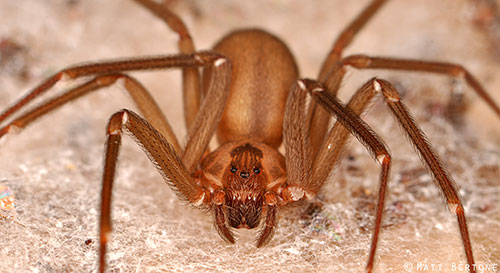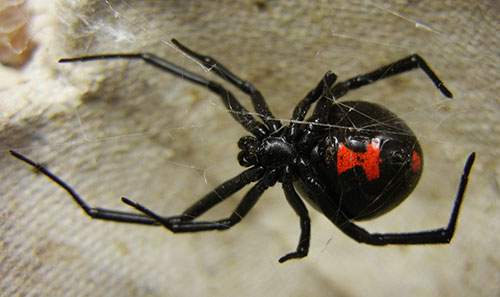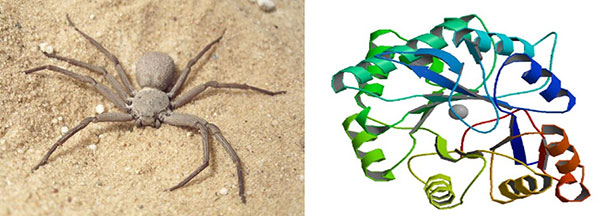
Female brown recluse spider. Credit Matt Bertone, North Carolina State University.
This Halloween, you’re not likely to see many trick-or-treaters dressed as spiders. Google Trends pegs “Spider” as the 87th most searched-for Halloween costume, right between “Hippie” and “The Renaissance.” But don’t let your guard down. Spiders are everywhere.
“I grew up on a farm in Indiana and had the luxury of exploring and turning over rocks and being curious. Any feelings of being grossed out by spiders were rapidly replaced by my feelings of awe for how amazing and diverse these creatures are.”– Greta Binford”
More than 46,000 species of spiders creepy crawl across the globe, on every continent except Antarctica. Each species produces a venom composed of an average of 500 distinct toxins, putting the conservative estimate of unique venom compounds at more than 22 million. This staggering diversity of venoms, collectively referred to as the venome, has only begun to be explored.
Among the handful of brave scientists studying spider venom are Greta Binford at Lewis and Clark College in Portland, Oregon, and Jessica Garb at the University of Massachusetts at Lowell. Both of these researchers analyze the protein structures of various venom chemicals in search of clues that can explain why some are lethal (see side bar below), while the vast majority are thought to be relatively harmless. The scientists also use molecular biology tools to compare the genomes of spiders that have extremely noxious venoms, including the black widow and the brown recluse, to those of spiders with non-poisonous venoms, such as the house spider.

Female black widow spider (Latrodectus mactans). Credit: Wikimedia Commons, Shenrich91.
“For some reason, I tend to gravitate to these really dangerous spiders like the black widow. But with their shiny black body adorned with the red hourglass, they’re actually quite elegant.” — Jessica Garb”
The data being collected by Garb and Binford and their colleagues have the potential to increase our understanding of the evolution of spider venom and hopefully contribute to the discovery of new medicines, anti-venoms and insecticides. In addition, because many of the deadlier spider venoms produce their toxic effects by overstimulating the production of brain signaling molecules, this research may uncover novel tools for neuroscience research.

Spiders in the genus Sicarius are among the deadliest on Earth. Binford studies a number of the toxins found in these spiders’ venom, including Sphingomyelinase D (right). While this toxin shares similarities with those found in the venom of the brown recluse, Sicarius spiders are much larger and their deadly payload is much more concentrated. The result is a venom so poisonous that cells near a bite literally burst like balloons, ultimately resulting in the death of wide swaths of tissue. The toxin can also slip into the bloodstream and rip apart red blood cells, as well as the arteries and veins that carry them. Eventually, so many blood cells and vessel linings succumb that both clotting and hemorrhaging occur throughout the body, leading to devastating events such as strokes, aneurysms and heart attacks. Adding to the terror these spiders inspire is their ability to descend on prey with extraordinary bursts of speed. Best to steer clear. Credit: Wikimedia Commons, Beliar spider (left) and Murakami, M.T., Gabdoulkhakov, A., Fernandes-Pedrosa, M.F., Betzel, C., Tambourgi, D.V., Arni, R.K., Protein Data Bank (right).





Appreciate